Coyote IV (1973-1978) Indy car-by-car histories
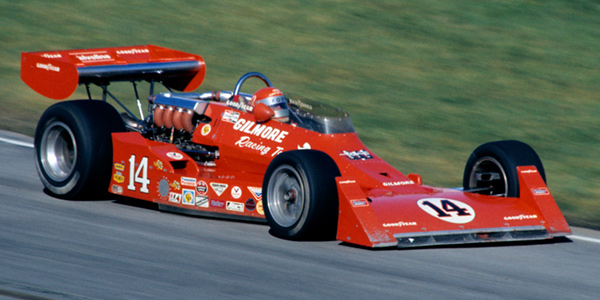
AJ Foyt in the second of his two 1974 Coyotes at Milwaukee in 1974. Copyright Glenn Snyder 2009. Used with permission.
Between 1973 and early 1979, AJ Foyt used a series of cars evolving from an original design by Bob Riley. Only four distinct cars were built, and Foyt won 19 races in them, with at least one victory in each of those seven seasons, including four 500-mile races.
After his 1972 Coyote design had been, in his own words, a "follow-the-leader car", Foyt's "pencil" Bob Riley was keen to reduce the frontal area of the 1973 car as much as possible, and hit on the idea of lowering the front suspension top wishbone to the centre of the wheel hub, thus allowing the tub to be several inches lower. The new Coyote IV was just under the maximum width of 80 inches, was 15 feet long, with a 104-inch wheelbase, and 32 inches high. At 1,500 lbs, it was 150 lb heavier than the previous year's car. The nose was full-width, following the "sports car nose" fashion of the time, with the radiators sitting up very high on the back of the sidepods. The car also had fixed plastic skirts which reduced the amount of air getting under the car, this producing a low-pressure area under the car and thus a degree of downforce. After Foyt credited his father Tony with the design, rather than Riley, Riley decided to move on, and joined Lindsey Hopkins' team for 1974.
The Foyt Enterprises team was in new livery for 1973, as Foyt had lost his long-time sponsor Sheraton-Thompson and found another long-term and lucrative arrangement with Jim Gilmore, heir to the Gilmore Brothers Department Store fortune. The new Gilmore-Coyote was immediately successful, Foyt winning his second race in the car at Trenton in April 1973. A second car was built in time for the Indy 500, and Foyt took another race win in that car at Milwaukee in June. After that, Foyt found the 1973 Eagles and the McLaren M16Cs were faster than his Coyotes, and those two wins were his only finishes higher than tenth that season. The pair of 1973 Coyotes were rebuilt into two new cars to a revised design for 1974, as described below, so in effect neither car now exists.
Over the five seasons that followed, Foyt used just four Coyote Indy cars: the two 1974 cars, a new, slimmer car built for the Indy 500 in 1975, and an almost-identical fourth car built in 1978. Out of the cars' 84 race starts, 71 were in Foyt's hands and the Texan won 19 races, more than any other driver over that period, and took pole position for 26 races, twice as many as his nearest rival. He won from pole nine times; over the period from 1973 to 1978, only four other drivers won from pole - Johnny Rutherford, Danny Ongais, Bobby Unser and Gordy Johncock - and none of them more than four times.
If you can add to our understanding of these cars, or have photographs that we can use, please email Allen at allen@oldracingcars.com.
New for AJ Foyt at the Texas 200 at Texas World Speedway in April 1973 as Foyt Enterprises' #14 Gilmore Racing entry. Photographs show that it was also raced by Foyt at Trenton, and then raced by George Snider at the Indy 500 as the #84 entry. It was then raced by Snider at Pocono, by Foyt at the Tony Bettenhausen 200 at Milwaukee in August, and by Snider at Ontario in September. The side-radiator 1973 Coyotes were not seen again after 1973 and were presumably rebuilt into the team's front-radiator 1974 cars.
Driven by: AJ Foyt and George Snider. First race: Texas World Speedway (R1), 7 Apr 1973. Total of 8 recorded races.
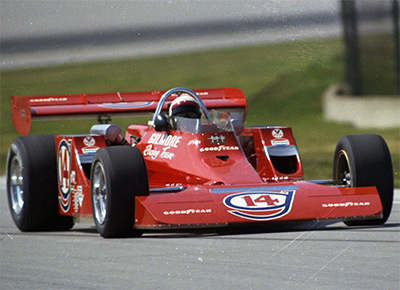
AJ Foyt in his new 1973 Coyote at the Indy 500 in 1973. Copyright Indianapolis Motor Speedway. Copyright permissions granted for non-commercial use by Indianapolis Motor Speedway.
New for AJ Foyt at at the 1973 Indy 500 as Foyt Enterprises' #14 Gilmore Racing entry. Photographs show that it was also raced by Foyt as the #14 at Pocono, Michigan in July, Ontario, Michigan again in September, and Trenton in September. It is likely to be the car raced by Foyt at Texas World Speedway in October and by George Snider at Phoenix in November, but this remains unconfirmed. The side-radiator 1973 Coyotes were not seen again after 1973 and were presumably rebuilt into the team's front-radiator 1974 cars.
Driven by: AJ Foyt and George Snider. First race: Indianapolis Motor Speedway (R4), 30 May 1973. Total of 9 recorded races.
Coyote '74
The two 1973 cars were extensively rebuilt for 1974, emerging as effectively new cars. The main radiators were moved from in front of the rear wheels to the nose, with only the oil coolers remaining on top of the monocoque in front of the rear wheels. As in 1973, the first car was used at the opening races of the season, and the second car was prepared in time for the Indy 500. However, the first car was damaged in an accident during practice at Trenton and when Foyt took pole position at the Indy 500 in the new second car, he stayed with that car for the rest of the season. Both cars were retained for 1975, with the first car being used on short tracks and the former Indy pole car at Ontario and Michigan. A new car was produced for 1975 which was reserved for the Indy 500 and Pocono only.
The second 1974 car was used again used as a short track car in 1976, but investigations continue to determine if both the 1974 cars were used that season. In 1977, Foyt won the Indy 500 in his 1975 car, and after publicly donating the winning car to the Speedway Museum, commented in the press that he only had one car left. That one car must have been the second 1974 car, suggesting that the first 1974 car had been lost, dismantled, or given away in the meantime. A new car was then built for 1978, but the well-used 1974 car was again used for much of that season, including as George Snider's mount at the two British Indycar races at the end of the 1978 season. The fate of the first car remains unresolved, but the second 1974 car was acquired by Gilmore and remains on display in the Gilmore Museum.
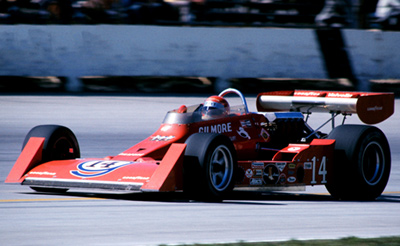
AJ Foyt in the older of his two 1974 Coyotes at Milwaukee in June 1975. Copyright Glenn Snyder 2014. Used with permission.
New for the start of the 1974 season, and raced by AJ Foyt as Foyt Enterprises' #14 Gilmore Racing entry at Ontario, Phoenix and Trenton. Foyt crashed in practice at Trenton and returned to base. He then raced a new, second,1974 Coyote at the Indy 500, and the only times this older car was seen was as his #10 backup car used in practice for the Indy 500, and then as the #10 entry driven by George Snider at Michigan in September. This older car was almost certainly the team's backup car at the start of the 1975 season, when it was the #10 entry prepared for Joe Leonard at Ontario in March 1975, and raced by Rick Muther after Leonard failed a medical. Photographs show that the same car was used by Foyt at short track races that season: Phoenix in March, Trenton in April, Milwaukee in June and August, Trenton in September, and Phoenix in November. This car reappeared at the start of 1976, now updated with the same style of bodywork used on the other 1974 car the previous year, and was raced by Foyt at Phoenix in March, Trenton in May, Milwaukee in June, and Trenton In August, where Foyt clipped the wall and retired with broken suspension. The car was not seen at all during 1977, and probably not in 1978, although this still remains uncertain. This car was not in the Foyt auction in 1992, and its current whereabouts are not known. One possibility is that it was extensively rebuilt as the 1978 car.
Driven by: AJ Foyt, George Snider and Rick Muther. First race: Ontario Motor Speedway (R1), 3 Mar 1974. Total of 15 recorded races.
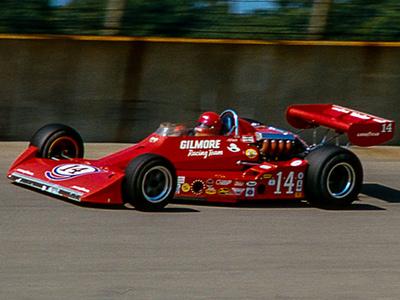
AJ Foyt in his Coyote '74 at Michigan in July 1976. Copyright Richard Deming 2016. Used with permission.
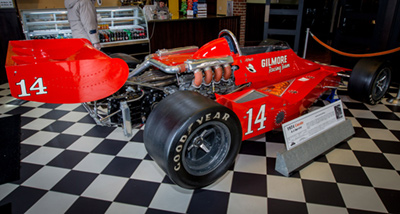
The second of the two 1974 Coyotes at the Gilmore Museum. Copyright Richard Deming 2016. Used with permission.
New for AJ Foyt at the 1974 Indy 500 as Foyt Enterprises' #14 Gilmore Racing entry. Photographs show that it was also raced by Foyt at Milwaukee in June, Pocono, Michigan in July, Milwaukee in August, probably Michigan again in September, Trenton in September and Phoenix in November. It was also used to set a new record speedway lap of 217.854 mph at Talladega on 3 August 1974. Photographs also show that this was one of three cars used by Foyt during the 1975 season: at Ontario in March, as his #10 backup car at the Indy 500, and at both Michigan races in July and September 1975. In 1976, Foyt raced the older 1974 car at early-season short track races and the newer 1975 car at the Indy 500, but used this car for every race from Pocono in June to the end of the season. In 1977, it was raced by Foyt at Ontario and Phoenix in March, TWS in April, Pocono, Mosport, and Trenton in September; and by Billy Vukovich at the Indy 500. In 1978, it was raced by Foyt at Phoenix in March, Trenton in April, Mosport, and Milwaukee in June, by Snider at Pocono, and probably at Michigan, where he hit the wall. It may be the car raced by Foyt in the August Milwaukee and by George Snider in the two races in Britain in October 1978, but this remains uncertain. Foyt then bought Parnelli VPJ6Cs, and the Coyotes were finally retired. This car passed to Foyt's long-time sponsor Jim Gilmore and was on display in his second-floor office in Kalamazoo, Michigan, and was in his living room at his home by 1985. After Gilmore died in a traffic accident in 2001, the Coyote moved to the Gilmore Museum, also in Kalamazoo, which had been founded by his uncle, Donald S. Gilmore in 1966. Its display board calls it a 1974 car, and that it was the Talladega record car. Still in the museum in July 2021.
Driven by: AJ Foyt, Janet Guthrie, Billy Vukovich and George Snider. First race: Indianapolis Motor Speedway (R6), 26 May 1974. Total of 36 recorded races.
Coyote '75
Foyt's team built an all-new Coyote for 1975, an evolution of the 1974 design, but described as narrower, with better aerodynamics and monocoque that was smaller and 2½ inches lower. This car was only used for the Indy 500 and the Pocono 500, the team's older 1974 cars being used at all the other races. The only time a second car was run all season was the one intended for Joe Leonard to drive at the Ontario 500, but raced by Rick Muther after Leonard failed a medical.
For the 1976 season, Foyt stuck with the same cars, using his 1975 car at the Indy 500, where he finished second, but the second of the two 1974 cars at most other races. For 1977, he again raced the 1975 car at the Indy 500, finally securing his historic fourth victory, and also won two other races at Ontario and Mosport in the older 1974 car. He donated the winning car to the IMS Museum, then claiming he only had one car left, but soon reclaimed it as a backup for the rest of the season. The donation now forgotten, the 1975 car was raced by George Snider as a second Foyt entry at the Indy 500 in 1978, and remained in Foyt's ownership until he auctioned all his remaining cars in 1992. At that point Tony George bought the car for the Indy Museum, where it has remained every since.
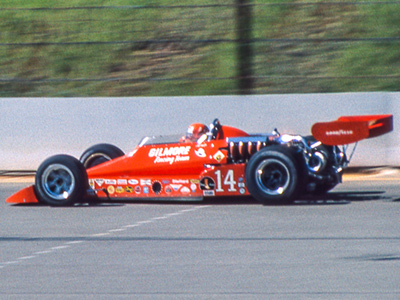
AJ Foyt in his 1975 Coyote at Pocono in June 1975. Copyright David A. Reese 2021. Used with permission.
New for AJ Foyt at the 1975 Indy 500 as Foyt Enterprises' #14 Gilmore Racing entry. This car was allegedly slimmer and lower than previous cars in this series. Photographs show that the next times Foyt raced this car were to win the Pocono 500 in June 1975, finish second at the Indy 500 in May 1976, and then to win the Indy 500 in 1977, Foyt's fourth win at the Speedway. Foyt then announced that the car had been donated to the IMS Museum, but it was later reclaimed and Foyt took it to second place at the California 500 at Ontario in September. The following year it was raced more often: by Foyt at the Ontario 200 in March and the Texas 200 in April, then it was George Snider's #84 entry at the 1978 Indy 500, was raced by Foyt at Michigan in July, then Foyt's winning ride at the 200-mile Texas Grand Prix at TWS in August that year, and finally Snider's #14 at the Ontario 500. After it was retired, the car was on display in the Indy Museum during the 1980s, but returned to Foyt to be auctioned in 1992. It was acquired by Tony George for $410,000, and returned to the IMS Museum. It has remained in the museum collection since then. It is sometimes loaned out, and between October 2008 and January 2009 was at the America On Wheels Museum (Allentown, PA) where it was described as the backup car, not the Indy winner! It was back in the IMS Museum in May 2017, September 2018, and August 2020, and during 2021.
Driven by: AJ Foyt and George Snider. First race: Indianapolis Motor Speedway (R6), 25 May 1975. Total of 11 recorded races.
Coyote '78
Having got through three seasons with the same two or three cars, Foyt eventually built a new Coyote for the 1978 Indy 500. It was much the same as its predecessors, but with detailed tidying. Although he won at Texas World Speedway in August 1978, the 1973 design was now very dated, and the power of the Foyt-Ford engines was no longer able to compensate. Foyt decided to buy Parnelli VPJ-6Cs, although these cars were hugely younger than his Coyotes. The new 1978 Coyote was taken to the UK for Foyt to race in the two British Indycar races, and he scored an impressive win at Silverstone in it. He also used to win at Texas World Speedway in April 1979, the last time he raced one of his 73-78 Coyotes.

The 1978 Coyote at the IMS Museum in May 2009. Licenced by Flickr user 'Interceptor73' under Creative Commons licence Attribution 2.0 Generic (CC BY 2.0). Original image has been cropped.
New for AJ Foyt at the 1978 Indy 500 as Foyt Enterprises' #14 Gilmore Racing entry. It was also raced by Foyt at Pocono in June, at Silverstone and Brands Hatch in October, and at Texas World Speedway in April 1979, the last race appearance of one of the 1973 series Coyotes. With two wins from five starts, it had an even greater record of success than the 1975 car. It was retained by Foyt and appeared to be almost completely unchanged when it was sold at the Foyt auction in 1992 to Tony George, who acquired it on behalf of the IMS Museum. The IMS Museum's two 1973-series Coyotes are both on display at different times. For example, the 1978 car was standing in for the 1977 500 winner in 2005, 2009, 2011, 2012, 2014, 2016, 2018 and 2019. Both cars were on display at times during 2021.
Driven by: AJ Foyt. First race: Indianapolis Motor Speedway (R5), 28 May 1978. Total of 5 recorded races.
Identifying the Coyotes
The 1975 car and the 1978 car are quite easy to identify as both cars had only a single fuel filler in the side of the left sidepod, and none in the right sidepod, whereas the two 1973/74 cars had two on the right and one on the left. The 1978 car then had differences in its rear suspension that distinguish it from the 1975 car. So the difficulty is telling the two 1973/74 cars apart. By close study of photographs, it is generally fairly straightforward to trace each car's life from the start to the end of each season, as Foyt's team would make relatively few changes to each car during the racing season, so the positions of sponsorship decals on the cars' sidepods become a very useful guide. Nose sections were often changed from race to race, but the main cockpit section was rarely changed, and the engine covers, many of which were different, also tended to stay with the same car during a season. At the end of each year, all the cars tended to be reworked ready for the new season, and this is when bodywork was often replaced and sponsorship decals were removed pending new deals. It is unusual for decals to remain in the same position from one season to another, the second 1974 car between 1977 and 1978 being a rare example. This means that tracing a car between seasons is significantly more difficult, and here we are reliant to a large degree on the comments in Carl Hungness's Indianapolis 500 Yearbooks. Hungness had access to the records of Bob Laycock, who worked as the Speedway's historian from 1969 onwards, remaining on the staff until 1993, and his "card index" showed the previous Indy 500 history of each entry. Although it was not always 100% accurate, and it was possible for Hungness to sometimes quote details of the wrong car if numbers had been swapped, mistakes in the yearbooks have proven to be quite rare. The key piece of evidence from Hungness concerning these 1974 Coyotes was from the 1977 Yearbook, when he described Vukovich's #84 car as having originally been Foyt's pole position car in 1974, then had only been used in practice in 1975 and 1976, with Janet Guthrie lapping in it in 1976. So this means the #14 entry at Indy in 1974 became the #10 entry at the Speedway in 1975, the #1 driven by Guthrie in 1976 and then the #84 entry in 1977. The histories above rely on that information from Hungness being correct, but it must be noted that it means that a distinctive engine cover seen on the older of the two 1974 cars in 1976 moved onto the newer of the two 1974 cars in 1977.
The fate of the fourth of this series of cars remains a puzzle. In 1993, just after the Indy Museum had acquired two of the cars at the Foyt auction, museum director Kent Lifflick was quoted saying that there were only three of these cars, the third belonging to Jim Gilmore.
To complete the photographic analysis we still need photographs of Foyt's #14 at Michigan in July 1977 (where he was a non-starter), Foyt's #14 at Texas in July 1977, Snider's #84 at Michigan in July 1978, and Foyt's #14 at Atlanta in July 1978.
We would also benefit from better pictures of Foyt's #14 at Milwaukee in August 1973, Foyt's #14 at Michigan in September 1973, Snider's #10 at Michigan in September 1974, Foyt's #14 at Texas World Speedway in October 1976, Foyt's #14 at Texas in April 1977, Foyt's #14 at Milwaukee in June 1978, and Snider's #14 at Ontario in September 1978.
The decals that appeared on Foyt's cars over this time, apart from Gilmore, Goodyear and Citicorp, included Ashland Oil, Bear Racing Services, Bell Helmets, Big A Auto Parts, Champion spark plugs, Chicago Pneumatic power tools, Clevite engine bearings, Crane Cams, DieHard batteries, Earl's Competition Plumbing, Federal-Mogul, Ideal, Ingersoll Rand, Loctite, Mac's, Mallory ignition, Monroe shock absorbers, Nikon, Perfect Circle piston rings, PPG paints, Powerhouse, Premier fasteners, Purolator oil filters, Raybestos brake pads, S-K Tools ('the Great Ones'), Sunnen machine tools, Valvoline motor oil, Wagner brake products, and, because this was Texas, Tony Lama cowboy boots. We would like to express our appreciation to their graphic designers for making their logos so distinctive even in blurred photographs.
Acknowledgements
My thanks to Simmo Iskül and 'gbl' for collecting and analysing a huge number of images to determine the exact racing history of each individual car built to this type. The exchange of clues between the three of us during November and December 2021 was such that at one point the editor was seeing Dzus fasteners in his sleep. At the time of writing, 198 different pictures have been used in this analysis which must be the most per car ever mustered for such a project on OldRacingCars.com. Thanks also to Michael McKinney, who co-owns an unfinished Coyote 73-series monocoque with Bill Wiswedel, for his input.
If you can add to our understanding of these cars, or have photographs that we can use, please email Allen at allen@oldracingcars.com.
These histories last updated on .